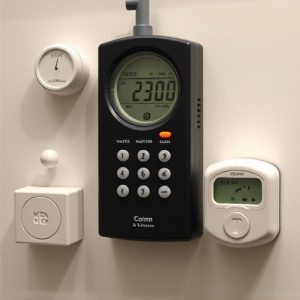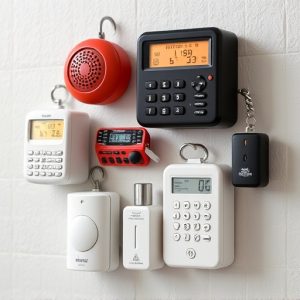Silent Alerts & Wearable Safety: Choosing Between Rechargeable & Battery Alarms
Wearable emergency devices with silent alerts offer discreet help in dangerous situations, with choi…….
Wearable emergency devices with silent alerts offer discreet help in dangerous situations, with choices between rechargeable and battery-powered alarms. Rechargeables, often solar-charged, provide prolonged use and environmental benefits but require initial investment. Battery-operated alarms are readily available at lower costs but need regular replacements. Considerations like sustainability, cost, ease of use, durability, and water resistance help determine the best option for personal safety needs, with both types offering peace of mind through silent alerts and mobile app integration.
In an era where personal safety is paramount, wearable emergency devices with silent alerts have emerged as a revolutionary tool. These innovative gadgets offer discreet yet potent solutions for unforeseen circumstances, empowering individuals to stay secure while going about their daily lives. This article delves into the intricacies of these lifesaving innovations, exploring key features like silent alerts and the timeless debate between rechargeable vs battery-powered personal alarms. By considering factors such as durability, reliability, and ease of use, readers will be equipped to make informed decisions regarding their choice of wearable safety device, staying one step ahead in an unpredictable world.
- Understanding Wearable Emergency Devices: A Lifesaving Innovation
- Silent Alerts: The Discreet Yet Powerful Feature
- Rechargeable vs Battery-Powered Personal Alarms: Pros and Cons
- Factors to Consider When Choosing Your Wearable Safety Device
- The Future of Personal Safety: Trends and Advancements
Understanding Wearable Emergency Devices: A Lifesaving Innovation
Wearable emergency devices have emerged as a groundbreaking solution in personal safety, offering a discrete yet powerful way to signal for help when faced with dangerous situations. These innovative gadgets are designed to provide peace of mind by allowing users to send silent alerts to emergency contacts or services during critical moments. One key distinction lies in their power source: rechargeable vs. battery-powered personal alarms. Rechargeable options, often featuring solar charging panels, ensure the device stays operational for extended periods without frequent battery replacements.
On the other hand, traditional battery-operated alarms provide instant readiness but require regular maintenance to avoid drainage and failure during emergencies. Despite this difference, both types offer vital functions like GPS tracking, automatic fall detection, and customizable alert settings. Their compact designs make them easily portable, ensuring users can access help discreetly in various environments, from outdoor adventures to urban navigation.
Silent Alerts: The Discreet Yet Powerful Feature
Silent alerts are a game-changer in wearable emergency devices, offering a discreet yet powerful feature that sets them apart from traditional personal alarms. Unlike loud sirens that can draw attention and potentially compromise safety in an already dangerous situation, silent alerts use subtle vibrations or gentle pulses to signal for help. This discrete approach is particularly beneficial in situations where the wearer needs assistance but prefers to avoid drawing public notice, such as when facing a potential attacker in secluded areas.
When comparing rechargeable vs battery personal alarms, silent alert devices often excel due to their energy-efficient design. Rechargeable options provide the advantage of constant readiness without the need for frequent battery replacements, ensuring the device is always operational. This feature is crucial for those who rely on these devices regularly, whether for outdoor activities, personal safety, or caregiving responsibilities.
Rechargeable vs Battery-Powered Personal Alarms: Pros and Cons
In the realm of wearable emergency devices, the choice between rechargeable and battery-powered personal alarms is a significant consideration for users. Rechargeable Vs Battery Personal Alarms offer distinct advantages and drawbacks. On one hand, rechargeable alarms eliminate the constant need to replace batteries, making them more environmentally friendly and cost-effective in the long run. Regular charging ensures these devices are always ready to activate silent alerts when needed, providing peace of mind for wearers. However, the initial investment for rechargeable models might be higher, and there’s a risk of dependency on consistent power sources.
In contrast, battery-powered personal alarms are readily available and often come at lower upfront costs. They don’t require charging, making them convenient for travel or situations where access to electrical outlets is limited. Yet, users must regularly replace batteries, which can be an added expense over time. The lifespan of these devices also tends to be shorter compared to rechargeables, as battery life eventually diminishes. Balancing these Rechargeable Vs Battery Personal Alarms pros and cons ultimately depends on individual needs, budget, and the specific use case for emergency protection.
Factors to Consider When Choosing Your Wearable Safety Device
When choosing a wearable emergency device, understanding the power source is key. The primary distinction lies between rechargeable and battery-powered personal alarms. Rechargeable options offer sustainability, eliminating the need for frequent battery replacements. This is particularly beneficial for long-term users or those in remote areas with limited access to resources. On the other hand, traditional battery-powered devices provide immediate backup, ensuring you’re prepared for unexpected situations without needing an outlet.
Factors like ease of use, durability, and additional features also play a significant role. Look for devices with clear and loud alerts, water resistance, and long-lasting batteries or efficient recharge times. Customizable settings for alert types and personal information are valuable additions, allowing users to adapt the device to their specific needs and preferences.
The Future of Personal Safety: Trends and Advancements
The future of personal safety is evolving rapidly, driven by technological advancements and a growing demand for discreet yet powerful solutions. Wearable emergency devices, especially those with silent alerts, are at the forefront of this revolution. One key trend is the shift from traditional battery-powered alarms to rechargeable alternatives, offering cost-effectiveness and environmental friendliness without compromising functionality. These innovative designs not only ensure users have a reliable safety net but also address common concerns about battery life and disposal.
Furthermore, advancements in sensor technology are enabling more sophisticated features, such as automatic fall detection, heart rate monitoring, and ambient noise analysis. These integrations allow for smarter decision-making during emergencies, ensuring that help arrives swiftly when needed most. The integration of mobile apps adds another layer of convenience, providing users with real-time tracking, alert customization, and peace of mind.
Wearable emergency devices with silent alerts represent a significant advancement in personal safety, offering discreet yet powerful protection. When choosing between rechargeable and battery-powered options (Rechargeable Vs Battery Personal Alarms), understanding the pros and cons is key. Considering factors like durability, reliability, and accessibility ensures you select the ideal device for your needs. Looking ahead, future trends in personal safety technology promise even greater peace of mind and enhanced capabilities.


